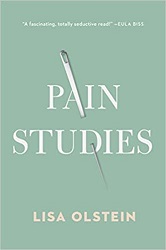
Review posted March 13, 2021.
Bellevue Literary Press, 2020. 191 pages.
Review written December 2, 2020, from a library book
Pain Studies is a book of musings about living with migraines. I’ve gotten migraines since I was a child, so I was ready for a book like this. Though it also made me thankful for how very much better they’ve gotten since menopause.
I’m not sure I approached this book in the best way, just a short chapter every day or two. Using that approach, I didn’t really catch her train of thought too well, so it felt like scattered musings about living with pain. When I look back, I see a few more themes than I remembered. Joan of Arc, for example, is mentioned in the last chapter, and I’d almost forgotten how much attention she’d gotten earlier in the book, as someone who experienced voices and visions other people didn’t understand – a little bit like how migraine sufferers experience things other people don’t understand.
This doesn’t try to pull meaning out of migraine, doesn’t try to make the reader see a higher purpose. I appreciated that, even if the result felt a little bit scattershot. But my own thoughts about migraines, when I have them, take on that same wide-ranging aspect. And I found many nuggets I appreciated. There’s a fellowship of migraineurs that none of us actually wants to be part of, but I recognized this voice speaking from that group.
Let me give you a couple of the nuggets I liked. This is in a chapter about the difficulty of describing pain:
The trouble with standard pain scales, it seems to me, is that they weren’t written by the right people – the people in pain. Often misheard as language that does not communicate, it turns out that the seemingly chaotic fragments of description people in pain manage to offer in fact cohere into meaningful systems of categorization. Researchers, Scarry tells us, have gathered up the shards and found logic in their arrangement, mapping dimensions relevant not only to diagnosis but also to treatment and sometimes even cure.
This one’s at the start when she’s introducing the topic of pain:
Drowning is one of the words we use to describe pain when we’re desperately in it, though often it’s used for other things, too: heartbreak, overwhelm. I’ve never experienced anything close to drowning, but I imagine that, like pain, it has a way of flooding you with the present. Yes, it makes you hazy, it fogs up memory’s edges, but in the moment, it is the moment and you are nowhere else except and only exactly where it puts you.
In some ways like any acute pain and in some ways possibly unlike any other, migraine is a particular version of the present. What happens when its present becomes yours for extended periods of time, for a significant portion of your life? This is the pain, or the present, I wish to discuss.
There’s a chapter toward the end that reminded me of all the times people asked me what caused my migraines.
Sometimes chance is cause, but is it ever what we mean by causality? Chance is cause stripped of meaning, an origin story or fated end without moral or lesson. (“People get what they get; it has nothing to do with what they deserve.” [House M.D.]) But any cause as yet unknown glows luminous. Answerless, we search for answers, because questions call and press. Somewhere out there, we feel sure, is the information that means, but, beyond our reach, it can’t matter yet. And when causality’s riddle turns out to be procedural or a purely chance operation, can it ever?
Maybe it’s a question of meaning versus meaningfulness. Chance may not teach us anything, but chance identified is a kind of answer and therefore a kind of balm, a version of no blame. I mean, in a way it’s reassuring how clearly the migraines come and go of their own volition, according to their own logic. One way of translating the void, the reams of unilluminating data, the typically atypical patterns: there’s nothing you did; there’s nothing you can do.
So this isn’t exactly a book I’m going to recommend to all my friends who get migraines. Because it’s not exactly comforting or inspiring. But on the other hand, it’s validating to read someone else’s musings on pain you’ve experienced. And if you’ve never experienced pain like this, perhaps reading this book will bring you a step closer to understanding.

